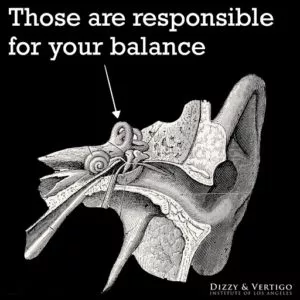What Are Otoconia? And How Do They Cause Vertigo?
- By Dizzy & Vertigo Institute
- December 31, 2021
The body’s ability to balance is one of nature’s most incredible developments. Although our balance system is made up of inputs throughout our body, the inner ear houses the GPS of our balance. And particles in the inner ear called otoconia are responsible for calibrating this GPS.
What Are Otoconia
The vestibular system is made up of many moving parts that detect gravity, movement, and motion. The parts work in unison to create, maintain, and correct our balance.
The two parts of the vestibular system responsible for sensing linear acceleration and gravity are the utricle and saccule. These parts contain tiny hair follicles and bio-crystals called otoconia, which send signals to the brain to maintain bodily balance during movement.
Otoconia are microscopic. You’d need to line up more than 25,000 of them to equal an inch!
The problem is that these microscopic crystals can get dislodged and find themselves in another part of the vestibular system called the semicircular canals.
We have three semicircular canals in each of our two inner ears. These canals (pictured below) are filled with fluid. As we turn our heads, that fluid moves and helps inform our body of our head’s location in space; another crucial part of maintaining balance.

For reasons researchers don’t yet understand, otoconia can get dislodged, find itself with the fluid in your semicircular canals, and throw off your body’s sense of balance. The result is vertigo.
The vertigo you feel is your body trying to understand this new information in the wrong part of your inner ear. In other words, your body is trying to make sense of mixed signals.
BPPV is the official diagnosis that results from otoconia getting dislodged in the inner ear and causing confusion in the vestibular system.
BPPV brings with it short bursts of rotational vertigo, lasting less than a minute. The vertigo episodes are typically brought on by positionally provoked movements such as sudden head movements, lying in bed, rolling onto either side in bed and bending over. These episodes may also be sporadic and unpredictable depending on the movement.
Anyone with BPPV will tell you that these microscopic particles can have a macroscopic effect on life. Fortunately, there is a solution to displaced otoconia.
Canalith Repositioning
When treating patients with BPPV, the first treatments we turn to are the Semont Maneuver or the Epley Maneuver – canalith repositioning maneuvers.
Basically, they are maneuvers we use to physically reposition the displaced otoconia into their appropriate placement within the inner ear.
In the span of 15 minutes (the time it takes to change bedsheets) we can cure positional vertigo! Pending a proper diagnosis, these maneuvers have an approximate success rate of 80%.
The Internet is filled with advice on how to do these maneuvers on your own. However, you don’t know which of the six semicircular canals is affected. It’s a risk that can result in making things worse and more uncomfortable than they were before.
Of course, some people find relief from BPPV within weeks or months without treatment, as these microscopic crystals can reposition in your inner ear with normal daily activities over time.
But I think we can all agree that it’s much better to work with an expert that has the equipment and experience to solve these issues quickly and with precision.
If you or someone you know struggles with vertigo or dizziness symptoms, then please contact us at (310) 683-4679 or by filling out our contact form here.
There is proven help out there and you don’t have to go on living with dizziness!
Lived with vertigo for years, A doctor fixed almost all of it in 15 minutes. Incredible!